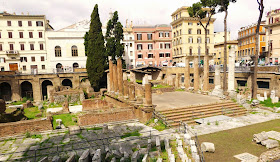But that was not entirely true.
The Wall, and earlier the Stanegate frontier that it roughly paralleled, were not a static, rigid edge of Empire. At various times the Legions marched practically to the furthest extremity of Scotland in their attempts to chastise and/or subjugate the stubborn inhabitants. For a while the Antonine Wall was the northern frontier. And even when Hadrian's Wall was where Rome officially ended, there were a series of outpost forts further north.
We don't quite understand this situation. In some instances they may have been an early warning system. Certainly they were linked by a system of signal towers to the main defensive line. In other cases they were friendly territory, tribesmen in the lowland regions might have been allied subordinate kingdoms or bought and paid mercenaries. Perhaps in other cases these really were the armed camps with lurking hostiles that our imagination would make them.
On our recent trip to Vindolanda we made a quick trip up to one of these outpost forts, a place called High Rochester. In Roman times it was called Bremium, and was located about 15 miles north of Hadrian's Wall on what is now called Dere Street.
Dere Street was one of the main north south roads heading north into Scotland, and High Rochester was an early site, built by Agricola on his punitive campaign after the Boudiccian revolt.
But today lets leave the fort aside. The most interesting thing at High Rochester are the tombs outside the fort.
On our little road trips we do tend to strike poses suitable for 1970's album covers.
As you can see the upper earthen dome is no longer present. A lot of it was probably removed when an Inland Revenue officer named William Coulson took a break from his usual job of intercepting whiskey shipments long enough to excavate this feature. He fount an urn with cremated remains , presumably of a Roman officer, and a coin of Septimus Severus (222-235).
One one of the stones there is a carving of a long eared animal of some sort. Fox, bunny, donkey, take your pick I guess.
The tombs at High Rochester are on a windy hillside. Sheep wander about. You are standing on the modern day border between England and Scotland. There is not much in the way of land marks although in places you can see the track of the ancient Roman road. We had heard that there were other tombs nearby so we scrambled up and down a while eventually running into a farmer who pointed us in the right direction.
There turned out to be about a dozen of these things, earthen mounds with a ditch around them. You can make out a row of three in this picture. Presumably these were the graves of lesser folk, or perhaps it is just a matter of any stone work being long gone. There are no records regarding excavations, but it is hard to imagine that there has not been a bit of midnight digging over the years.
Pete relaxing atop an ancient Roman grave. I am not sure why this struck me as a bit more cheeky than the entire bunch of us standing on top of the bigger example. Maybe because I knew the occupant of that one had moved elsewhere circa 1850? We had another week of excavation ahead of us so I decided to play it safe. After Pete got up I carefully put a 10 pence coin down as an offering to the Manes and the Lares. As we went on to have a very productive week my little gesture must have done some good.




















































